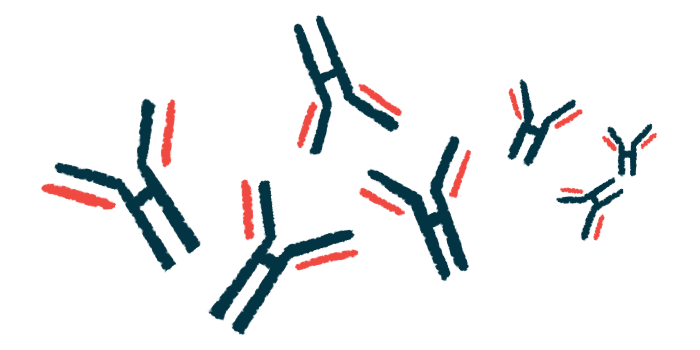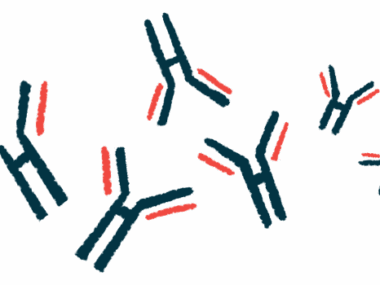Rheumatoid factor in NMOSD linked to long-term disability: Study
Half of AQP4-related NMOSD patients test positive for other autoantibodies
Written by |

About half of neuromyelitis optica spectrum disorder (NMOSD) patients who test positive for self-reactive antibodies, or autoantibodies, against the AQP4 protein — a hallmark of the autoimmune disease — have at least one other type of autoantibody, according to a new study from South Korea.
Many of these other autoantibodies have been associated with other autoimmune conditions, according to the researchers, who noted that patients testing positive for one such autoantibody, rheumatoid factor or RF, had significantly higher rates of worse disability and their disease progressed faster.
“We revealed that Korean patients with NMOSD have a high prevalence of organ- and non-organ-specific autoantibodies, of which RF is particularly associated with long-term disability,” the researchers wrote, adding that “large-cohort [group] prospective studies are necessary to investigate the clinical significance of RF in NMOSD.”
The study, “Potential prognostic value of rheumatoid factor in anti-aquaporin 4-immunoglobin G-positive neuromyelitis optica spectrum disorders,” was published in the Journal of the Neurological Sciences.
Investigating the impact of coexisting autoantibodies in NMOSD
In NMSOD, the immune system promotes damaging inflammation in the spinal cord and the optic nerve, which relays signals between the eyes and the brain. This leads to an array of symptoms, including pain, vision loss, and muscle weakness. Episodes of inflammation reoccur periodically, separated by periods of remission.
About 70% of NMOSD cases are associated with the production of autoantibodies targeting AQP4, a protein predominantly found in astrocytes — star-shaped cells in the brain and spinal cord that support nerve cells. When astrocytes are attacked, the ensuing inflammation leads to damage to the surrounding nerve cells.
Many NMOSD patients also have whole-body autoimmune diseases, ones marked by immune attacks against multiple organs or body systems. These conditions include systemic lupus erythematosus, Sjögren’s disease, rheumatoid arthritis, and myasthenia gravis.
Further, non-organ-specific autoantibodies related to whole-body autoimmune diseases have been reported in up to about half of NMOSD patients.
“However, the clinical implication of coexisting autoantibodies has rarely been investigated in patients with … NMOSD,” the researchers wrote.
To learn more, a team of researchers from across the Republic of Korea assessed the rates of non-organ-specific autoantibodies among NMSOD patients. The team sought to determine whether these autoantibodies were associated with disability, including long-term disability.
Looking at data from a Korean nationwide registry for NMOSD and related conditions, the team identified 158 NMOSD patients positive for anti-AQP4 autoantibodies. Most (about 92%) were women, and altogether, they had lived with the disease for a mean of 9.8 years.
Neurological lesions most commonly affected the spinal cord (78.5%), followed by the optic nerve (59.5%) and brain (34.2%). The mean Expanded Disability Status Scale (EDSS) score at the patients’ last visit was 3.2, with 24 individuals (15.2%) having an EDSS score of at least six, indicative of a high disability level.
The EDSS is a 10-point scale measuring a patient’s level of disease-related disability, with higher scores indicating worse disability. A score of six or higher means that a patient requires a walking aid.
A subset of participants had coexisting autoimmune diseases, including 18 people (11.4%) with Sjögren’s disease, 13 (8.2%) with autoimmune thyroid disease, and four (2.5%) with systemic lupus erythematosus.
Findings show RF is ‘associated with long-term disability’
The most common autoantibody was the antinuclear antibody, found in one-third of patients. This was followed by anti-Sjogren’s syndrome A autoantibodies, seen in 28.6% of patients, and anti-Sjogren’s syndrome B autoantibodies, found in 10%. All of these autoantibodies are associated with many autoimmune diseases and are measured in diagnostic tests.
Two types of self-reactive antibodies associated with autoimmune thyroid disease were also detected in 11.9% to 14.5% of patients.
The proportion of patients with at least one organ- or non-organ-specific autoantibody was 50.6%, and the prevalence of each autoantibody ranged from 1.9% to 33.3%.
Of the 140 NMOSD patients with available data, 12 — 8.5% of the total, and all women — tested positive for rheumatoid factor, an autoantibody associated with rheumatoid arthritis and other autoimmune diseases. Three of these women were also diagnosed with Sjögren’s and two had autoimmune thyroid disorder, but none had a rheumatoid arthritis diagnosis.
Overall, “the proportion of patients with at least one organ- or non-organ-specific autoantibody was 50.6%, and the prevalence of each autoantibody ranged from 1.9% to 33.3%,” the researchers wrote.
No significant differences were detected between patients with and without specific autoantibodies, except for RF.
The 12 women with RF autoantibodies had a significantly higher mean EDSS score (4.7 vs. 3.1) and significantly higher rates of severe disability, reflected by an EDSS score of six or higher (45.5% vs. 14.5%) than the 128 patients without RF.
Also, the median time to severe disability was significantly shorter for patients with RF than for those without this autoantibody (17.6 vs. 26.8 years).
Further statistical analyses showed that older age at disease onset and testing positive for RF were independent risk factors for a shorter time to reach severe disability.
These findings suggest that people with AQP4-related NMOSD frequently have other autoantibodies “and that RF is associated with long-term disability,” the researchers wrote.
According to the team, larger studies are needed to confirm these findings and the clinical significance of RF and other self-reactive antibodies in NMOSD.







